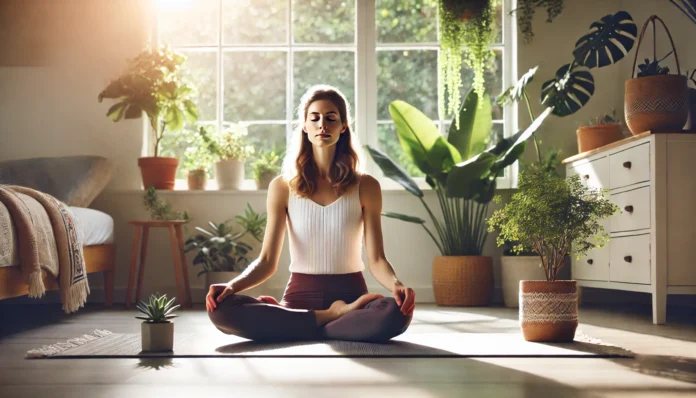In a world that rarely slows down, where stress and anxiety seem to be the background noise of everyday life, the idea of simply pausing to take a deep breath might appear too simple to be effective. Yet science continues to affirm what ancient traditions and modern clinicians have long observed—deep breathing, when practiced intentionally and correctly, can be a profoundly powerful tool for emotional regulation, physical health, and mental clarity. This article explores the physiological and psychological mechanisms behind deep respirations, reveals how breathing exercises for anxiety can recalibrate the nervous system, and offers a practical guide to incorporating different breathing techniques into daily life. From the intricacies of vagal tone to the nuances of breathing meditation for anxiety, we’ll delve deep into how to practice deep breathing in a way that supports lasting change.
You may also like: Proven Relaxation Techniques for Stress and Anxiety: Evidence-Based Strategies to Calm Your Mind and Body
Understanding the Physiology of Breath: Why Deep Breathing Works
The human body is an exquisitely designed system where breath plays a central role—not just in oxygen exchange but in autonomic regulation. Deep breaths influence the balance between the sympathetic and parasympathetic nervous systems. When stress triggers the fight-or-flight response, the sympathetic system ramps up, increasing heart rate and cortisol levels. This state, if prolonged, contributes to a cascade of physiological effects that manifest as anxiety symptoms, including rapid heartbeat, shallow breathing, digestive issues, and even feelings of derealization.
Taking the time to breathe in and out deeply activates the parasympathetic nervous system, specifically via the vagus nerve, which signals the body to relax. This practice lowers heart rate, reduces blood pressure, and encourages a state of calm. For individuals suffering from chronic stress or anxiety, engaging in deep breathing exercises is not just about relaxation—it’s about rewiring the body’s response to stress. Research shows that consistent practice of deep breathing exercises for stress can lead to measurable reductions in anxiety symptoms and improvements in emotional resilience.
How Breathing Influences the Mind-Body Connection
The mind and body are intimately connected, and nowhere is this more evident than in the act of breathing. Conscious breathing bridges the gap between involuntary physiological functions and deliberate mental focus. When you take a moment to relax and breathe with intention, you’re not just calming your body—you’re also creating space for mental clarity and emotional regulation.
Breathing techniques for anxiety provide a unique opportunity to intervene in the physiological feedback loop that perpetuates worry and tension. For example, shallow, rapid breathing—a common symptom of anxiety—can itself trigger more anxiety by creating sensations of air hunger or dizziness. This can escalate into a cycle of panic. By practicing controlled, slow breaths, individuals can break this cycle and restore a sense of balance. The use of stress relief breathing exercises as a self-regulatory tool helps to diminish the intensity of anxious thoughts while improving body awareness and mindfulness.
Can Deep Breathing Help Anxiety? What the Science Says
There is growing evidence in both clinical psychology and neuroscience that supports the role of deep breathing in managing anxiety. Functional MRI studies have shown that deep respirations alter activity in brain regions associated with emotional regulation, such as the amygdala and prefrontal cortex. When you learn how to breathe deeply, you are influencing these brain regions in a way that promotes calm and cognitive control.
A study published in the Journal of Clinical Psychology found that participants who engaged in daily deep breathing training experienced significant decreases in trait anxiety over just eight weeks. Similarly, mindfulness-based interventions that incorporate breathing exercises for depression and anxiety have demonstrated efficacy comparable to medication in some individuals. It’s not just that breathing helps people feel better—it actually changes the way the brain and nervous system function.
Understanding how to practice deep breathing means understanding that it’s not a quick fix, but a skill. Like any physiological practice, it requires consistency and intention. Over time, regular practice leads to neuroplastic changes that reinforce a calm, balanced state as the default, rather than reactivity and fear.
Different Types of Breathing Techniques for Anxiety and Stress
There are numerous types of breathing techniques available, each with unique benefits. Some are designed to energize the body, while others promote deep relaxation. Understanding which breathing methods for anxiety work best for you can make a significant difference in how effective your practice becomes.
Box breathing is a popular technique that involves inhaling for four seconds, holding the breath for four seconds, exhaling for four seconds, and then holding again for four seconds. This rhythmic approach helps to stabilize the breath and calm the nervous system. Compared to 4-7-8 breathing, which emphasizes a longer exhalation phase to deepen relaxation, box breathing can feel more structured and even-paced, making it particularly useful in moments of acute stress.
Another effective method is diaphragmatic breathing, also known as belly breathing. This technique emphasizes the movement of the diaphragm rather than the chest, promoting full oxygen exchange and greater parasympathetic activation. People often ask, “How can breathing help with stress?” The answer lies in how diaphragmatic breathing slows down the heart rate and encourages muscle relaxation, signaling the body that it’s safe.
Breath counting, alternate nostril breathing, and resonance breathing are other types of breathing techniques that have shown promise. Incorporating multiple methods into your routine allows for flexibility and adaptability, ensuring you have the right tool for any situation. Whether you’re facing social anxiety, work pressure, or general overwhelm, there’s a breathing technique that can meet you where you are.
The Role of Breathing Meditation for Anxiety Relief
Breathing meditation for anxiety merges mindfulness practices with conscious breathwork, creating a dual-layered approach to calming the mind. In traditional meditation, the breath serves as an anchor for attention, gently redirecting the mind each time it wanders. When paired with deep breathing exercises, this approach becomes a powerful method for managing emotional distress.
Inhaling and exhaling with awareness allows individuals to tune into the present moment, moving away from anxious projections about the future or ruminations about the past. Over time, this practice enhances interoceptive awareness—the ability to sense internal bodily states—which is often impaired in individuals with anxiety disorders. The improved self-awareness that comes with regular breathing meditation supports emotional resilience and provides a grounded sense of self.
This approach is especially helpful for those seeking a non-pharmacological method of anxiety management. As more people turn to holistic and integrative therapies, breathing meditation stands out for its accessibility, minimal side effects, and scientific backing. When practiced regularly, it reinforces the neural pathways that support calmness, focus, and emotional stability.

How to Do Breathwork Correctly: Foundations for Success
Learning how to do breathwork starts with creating the right environment. Find a quiet, comfortable space where you can sit or lie down without distraction. Begin by simply observing your breath without changing it. Notice its depth, rhythm, and quality. This initial awareness lays the foundation for deeper work.
Once you’ve attuned to your natural breath, begin introducing gentle modifications. Aim for inhalations that fill the lungs slowly, followed by unforced, extended exhalations. The exhale phase is especially important in triggering the relaxation response, so give it time and attention. Use tactile cues—such as placing a hand on your abdomen—to guide diaphragmatic expansion.
It’s crucial not to rush this process. Breathwork is not about performance, but about presence. Even short daily sessions of five to ten minutes can be transformative if done consistently. Over time, these short sessions accumulate, building new habits of awareness and calm. For those wondering, “Do breathing exercises work?” the evidence is clear: when practiced correctly and regularly, they can significantly improve mental health and resilience.
Common Challenges in Breathing Training and How to Overcome Them
While the concept of breathing training may seem straightforward, many individuals encounter obstacles that hinder their progress. One common issue is difficulty maintaining focus. In our distraction-heavy culture, even sitting still for a few minutes can feel challenging. This is where structured techniques like box breathing or 4-7-8 breathing can be especially helpful, providing a mental framework that supports sustained attention.
Another challenge is physical discomfort. People unaccustomed to deep breathing may experience dizziness, tension, or even anxiety when starting out. This can be alarming, but it’s usually temporary. These sensations often arise from hyperventilation or poor posture. Adjusting your position, breathing more slowly, or shortening the sessions can help you ease into the practice.
Skepticism about whether deep breathing exercises truly work is another barrier. This often stems from expecting immediate results. While some benefits can be felt right away—such as reduced muscle tension or slower heart rate—the full impact of breathing training unfolds over time. Patience and consistency are key. Building a sustainable practice means allowing the process to unfold without judgment or pressure for perfection.
Integrating Breathing Exercises into Daily Life for Long-Term Benefits
The most effective stress relief breathing exercises are the ones that become part of your daily rhythm. You don’t need a dedicated meditation cushion or a special app—though those tools can help. What matters most is consistency. Begin by attaching breathing practice to existing habits. For example, take a few deep breaths every morning before getting out of bed or while waiting for your coffee to brew.
Throughout the day, use moments of transition—such as stepping into a meeting, commuting, or preparing for sleep—as cues to pause and breathe. These brief moments of awareness can disrupt the automatic pilot mode that often fuels stress and anxiety. With time, your nervous system becomes more adept at shifting into a relaxed state without effort.
It’s also helpful to periodically assess your technique. Are you still breathing into your chest rather than your belly? Has your pace become rushed? A few minutes of intentional breathwork at the end of each week can help recalibrate your practice. By making deep breathing a lifestyle rather than a task, you unlock its full potential.
Why Deep Breathing Is More Than a Relaxation Tool
While most people associate deep breathing with stress relief, its benefits extend much further. Deep breathing improves oxygen efficiency, enhances sleep quality, and even supports digestion by stimulating the vagus nerve. It’s a practice rooted in evolutionary biology, with effects that ripple across multiple systems of the body.
In cardiovascular health, for example, controlled breathing helps reduce hypertension by improving baroreflex sensitivity—a mechanism that helps regulate blood pressure. In immune function, deep breathing exercises have been linked to reduced inflammation and improved resilience to illness. These systemic benefits demonstrate that learning how to get deeper breaths isn’t just about mental health—it’s about whole-body vitality.
In the context of performance, athletes and high-performing professionals alike use breathing techniques to enhance focus, improve endurance, and manage high-stakes pressure. These real-world applications showcase how mastering the breath can yield tangible benefits far beyond relaxation. Understanding how to breathe deeply becomes not just a wellness tool, but a foundation for personal growth and achievement.

Frequently Asked Questions: Deep Breathing Techniques for Anxiety and Stress
1. How can I tell if I’m breathing correctly during deep breathing exercises?
Many people mistakenly believe they are doing deep breathing exercises correctly when, in fact, they are still engaging in shallow chest breathing. One of the easiest ways to check is to place one hand on your chest and the other on your abdomen as you breathe in and out. During proper deep breathing exercises, your abdominal hand should rise more than your chest hand. This indicates that you’re engaging your diaphragm, which is essential for effective deep respirations. Additionally, focusing on slowing your exhalation helps reinforce the calming effects of the breath and ensures you’re fully activating the relaxation response.
2. Are there advanced breathing techniques for anxiety beyond the basics?
Yes, beyond foundational breathing techniques for anxiety like diaphragmatic breathing or 4-7-8 breathing, more advanced practices involve breath retention, pacing strategies, and even guided visualization. Practices such as coherent breathing (which maintains a consistent pace of five breaths per minute) and holotropic breathwork (which involves accelerated deep breaths) can help unlock deeper emotional release when used under professional supervision. These different breathing techniques tap into the body’s physiological rhythms, facilitating not only stress relief but also long-term self-regulation. Breathing training with a certified coach can help personalize these methods for your unique needs. While advanced techniques are powerful, it’s essential to build a solid foundation first to avoid overstimulation.
3. Can breathing exercises for anxiety help during a panic attack?
Breathing exercises for anxiety can be very effective in managing the acute symptoms of a panic attack, especially when practiced beforehand. Techniques like box breathing and extended exhalations can redirect attention from spiraling thoughts and help stabilize the autonomic nervous system. The trick is to avoid taking overly forceful or rapid deep breaths, which can inadvertently worsen hyperventilation. Instead, a steady rhythm that emphasizes slow, controlled exhalations often brings the quickest relief. Incorporating stress relief breathing exercises into your routine trains your body to respond more calmly under pressure.
4. How do I integrate breathing exercises into my workday without feeling awkward?
You don’t need to sit in a quiet room to gain the benefits of deep breathing techniques. Micro-practices can be seamlessly integrated into your routine—during coffee breaks, while waiting for a file to download, or even while reading emails. For example, taking a deep breath and counting to four during transitions between meetings can significantly reduce cumulative stress. These types of breathing exercises can be done subtly and discreetly, making them perfect for workplace environments. With regular use, breathing methods for anxiety become second nature and support better focus and emotional composure throughout the day.
5. What role does posture play in breathing techniques for anxiety?
Posture has a profound impact on how effectively you can take deep breaths. Slouching compresses the diaphragm and restricts lung expansion, making it difficult to practice any breathing exercise correctly. Sitting or standing with an upright spine and relaxed shoulders allows for deeper, more effective respirations. Awareness of your body’s alignment is especially important when engaging in breathing exercises for stress, as poor posture can reinforce tension. Incorporating posture checks into your breathing training ensures you’re getting the full physiological benefit of each breath.
6. How do different breathing techniques affect heart rate variability (HRV)?
Heart rate variability is a marker of the body’s ability to adapt to stress, and certain breathing techniques for anxiety have been shown to positively influence HRV. Practices like resonance breathing—where you breathe at a frequency that synchronizes heart rate and respiratory rhythm—can increase HRV and signal a healthy, balanced nervous system. Deep breathing exercises that extend the exhalation phase help regulate vagal tone, another key factor in heart-brain communication. These changes are especially useful for those using breathing exercises for depression or chronic stress conditions. Over time, higher HRV is associated with improved emotional regulation, reduced anxiety, and better cognitive flexibility.
7. What should I do if deep breathing makes me feel dizzy or anxious?
Feeling lightheaded or anxious during a breathing exercise is often a sign that you’re either breathing too quickly or taking in more air than you’re exhaling. To stop heavy breathing anxiety, try shortening your inhalations and lengthening your exhalations, even counting out loud if needed to stay steady. It’s also helpful to return to natural breathing temporarily and avoid forceful breaths. This is a normal part of breathing training, especially for beginners who are adjusting to new patterns. If discomfort persists, working with a breathwork instructor or starting with shorter sessions can make a significant difference.
8. Can children or teens benefit from breathing meditation for anxiety?
Absolutely. Teaching breathing meditation for anxiety to younger individuals can build emotional intelligence, resilience, and self-awareness from an early age. Games that involve breathing through a straw, blowing bubbles, or using apps with visual breath guides can make the practice engaging. These activities train kids to relax and breathe mindfully without overwhelming them with formal techniques. For teens, techniques like 4-7-8 or simple breath counting can be powerful tools for managing academic stress or social anxiety. Introducing deep breathing exercises at a young age instills lifelong habits for managing emotional health.
9. How do I know which types of breathing exercises are right for me?
Choosing among the various types of breathing exercises depends on your goals and personal responses. Some people respond well to structured methods like box breathing vs 4 7 8 techniques, while others prefer the intuitive flow of breathing meditation for anxiety. Journaling after practice can help you track which techniques produce the most noticeable benefits. It’s also useful to experiment with different breathing techniques at various times of day—morning, midday, and evening—to assess how they influence your energy and mood. Flexibility in your approach allows you to develop a personalized breathing toolkit.
10. What are some overlooked benefits of learning how to breathe deeply?
Beyond managing anxiety, learning how to breathe deeply can enhance sleep quality, digestive function, and even immune response. Deep respirations stimulate the parasympathetic nervous system, which supports restful states that are crucial for repair and regeneration. Additionally, engaging in breathing exercises for depression has shown promise in reducing fatigue and cognitive fog by improving oxygen delivery to brain tissue. Athletes often use breathing techniques to enhance endurance and recovery, demonstrating their value in physical performance as well. Whether your goal is mental clarity, better health, or improved focus, deep breathing exercises offer a multidimensional path to well-being.

A Final Reflection: Relax and Breathe—Harnessing the Science of Breath for Lifelong Stress Relief
In the hustle of daily life, the simple act of pausing to breathe in and out with awareness can become a revolutionary practice. Breathing is always available, always free, and when wielded with intention, remarkably effective. Learning how to practice deep breathing isn’t about perfection; it’s about presence, consistency, and allowing your body and mind to recalibrate.
The question, “Does deep breathing help with anxiety?” has been answered by neuroscience, clinical psychology, and the lived experiences of countless individuals. The answer is a resounding yes—but only when practiced with commitment. The diverse types of breathing exercises, from box breathing vs 4 7 8 methods to diaphragmatic breathing and beyond, offer a customizable approach to mental wellness.
Integrating breathing exercises for anxiety and breathing exercises for stress into your daily life may seem like a small act, but over time, it creates a profound shift. Whether you’re facing a stressful meeting, coping with intrusive thoughts, or simply seeking to improve your baseline sense of well-being, take a deep breath and breathe. Let this moment become the beginning of your journey toward a calmer, more connected self.
From ancient wisdom to cutting-edge science, the breath has always been a gateway to balance. So relax and breathe. Your nervous system, your heart, and your future self will thank you.
controlled breathing for calm, mindful breathing practices, vagus nerve stimulation, nervous system regulation, natural anxiety remedies, calming breathing rituals, parasympathetic activation, slow breathing methods, mental health breathwork, emotional regulation tools, holistic stress relief, breath-led mindfulness, meditation breathing focus, somatic stress techniques, wellness breathing habits, self-regulation strategies, breath awareness training, mind-body relaxation, therapeutic breathing methods, anxiety calming techniques
Further Reading:
10 Breathing Techniques for Stress Relief
3 breathing exercises to relieve stress
Meditation: A simple, fast way to reduce stress
Disclaimer
The information contained in this article is provided for general informational purposes only and is not intended to serve as medical, legal, or professional advice. While Health11News strives to present accurate, up-to-date, and reliable content, no warranty or guarantee, expressed or implied, is made regarding the completeness, accuracy, or adequacy of the information provided. Readers are strongly advised to seek the guidance of a qualified healthcare provider or other relevant professionals before acting on any information contained in this article. Health11News, its authors, editors, and contributors expressly disclaim any liability for any damages, losses, or consequences arising directly or indirectly from the use, interpretation, or reliance on any information presented herein. The views and opinions expressed in this article are those of the author(s) and do not necessarily reflect the official policies or positions of Health11News.


